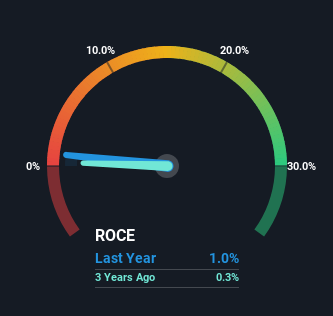Finding a business that has the potential to grow substantially is not easy, but it is possible if we look at a few key financial metrics. Amongst other things, we'll want to see two things; firstly, a growing return on capital employed (ROCE) and secondly, an expansion in the company's amount of capital employed. If you see this, it typically means it's a company with a great business model and plenty of profitable reinvestment opportunities. However, after investigating Auxilia (WSE:AUX), we don't think it's current trends fit the mold of a multi-bagger.
We've discovered 5 warning signs about Auxilia. View them for free.Understanding Return On Capital Employed (ROCE)
If you haven't worked with ROCE before, it measures the 'return' (pre-tax profit) a company generates from capital employed in its business. To calculate this metric for Auxilia, this is the formula:
Return on Capital Employed = Earnings Before Interest and Tax (EBIT) ÷ (Total Assets - Current Liabilities)
0.01 = zł425k ÷ (zł47m - zł6.5m) (Based on the trailing twelve months to December 2024).
Thus, Auxilia has an ROCE of 1.0%. In absolute terms, that's a low return and it also under-performs the Consumer Services industry average of 9.9%.
Check out our latest analysis for Auxilia

Historical performance is a great place to start when researching a stock so above you can see the gauge for Auxilia's ROCE against it's prior returns. If you're interested in investigating Auxilia's past further, check out this free graph covering Auxilia's past earnings, revenue and cash flow.
So How Is Auxilia's ROCE Trending?
On the surface, the trend of ROCE at Auxilia doesn't inspire confidence. To be more specific, ROCE has fallen from 14% over the last five years. Meanwhile, the business is utilizing more capital but this hasn't moved the needle much in terms of sales in the past 12 months, so this could reflect longer term investments. It may take some time before the company starts to see any change in earnings from these investments.
On a side note, Auxilia has done well to pay down its current liabilities to 14% of total assets. That could partly explain why the ROCE has dropped. Effectively this means their suppliers or short-term creditors are funding less of the business, which reduces some elements of risk. Since the business is basically funding more of its operations with it's own money, you could argue this has made the business less efficient at generating ROCE.
In Conclusion...
To conclude, we've found that Auxilia is reinvesting in the business, but returns have been falling. And investors appear hesitant that the trends will pick up because the stock has fallen 48% in the last five years. Therefore based on the analysis done in this article, we don't think Auxilia has the makings of a multi-bagger.
Auxilia does have some risks, we noticed 5 warning signs (and 3 which make us uncomfortable) we think you should know about.
While Auxilia may not currently earn the highest returns, we've compiled a list of companies that currently earn more than 25% return on equity. Check out this free list here.
New: Manage All Your Stock Portfolios in One Place
We've created the ultimate portfolio companion for stock investors, and it's free.
• Connect an unlimited number of Portfolios and see your total in one currency
• Be alerted to new Warning Signs or Risks via email or mobile
• Track the Fair Value of your stocks
Have feedback on this article? Concerned about the content? Get in touch with us directly. Alternatively, email editorial-team (at) simplywallst.com.
This article by Simply Wall St is general in nature. We provide commentary based on historical data and analyst forecasts only using an unbiased methodology and our articles are not intended to be financial advice. It does not constitute a recommendation to buy or sell any stock, and does not take account of your objectives, or your financial situation. We aim to bring you long-term focused analysis driven by fundamental data. Note that our analysis may not factor in the latest price-sensitive company announcements or qualitative material. Simply Wall St has no position in any stocks mentioned.
About WSE:AUX
Auxilia
Provides services for the victims of accidents and their families.
Medium-low risk with excellent balance sheet.
Market Insights
Community Narratives




